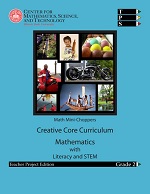Second Grade Mathematics

Operations and Algebraic Thinking
Museum Heist
The students are divided into groups. Each group is allowed to determine what section of a museum they wish to design. They make a list of the items needed for their display and make them from construction paper. They set up their display and go home for the evening. The teacher sets up a security camera outside the room and records bumbling thieves in masks entering the room. They move the camera inside and record the thieves covering the camera.
The teachers then mark out a 5x5 grid on the floor with string and tape and hide museum items inside the grid. They must hide the same number of items in one row and one column. They move the camera back outside and record them leaving, obviously empty-handed. When students arrive the next day, they are kept from the grid with crime scene tape. They do an inventory to determine the number of items stolen. They make a 5x5 data table and record where they find the items. The 5x5 grid full of numbers can be used for adding. The one row and one column can be used for multiplication.
Numbers of Operations in Base Ten
Math Mini-choppers
Each student makes a mini motorcycle chopper from copied cardstock and craft sticks. They add a back wheel, handle bars, front wheel, etc. They then customize their chopper by buying an engine, fuel tank, seat, back rest, headlight, etc. There is a list of required items and a list of optional items. Each item has a price. Different colors are different prices. All are copied from a master on construction paper.
Once finished, prices are totaled and retail prices are determined by adding for labor and rounding up to the nearest 100. The students are then organized into dealerships and prices are totaled. They create 6 more choppers on order forms to bring their total inventory to 10. Dealerships can merge to form larger groups of 10. Other transactions are possible.
Measurement and Data
Growing Flowers
Students experience data collection and graphing as they determine hair color and eye color of classmates. They graph the results. They then plant flowers and measure growth. Data tables and graphs are created.
Geometry
Cake Walk
Students determine serving sizes and calculate how many cakes they need. They draw out how to decorate the cakes by using geometric shapes and measurements. They may actually make the cakes if time and facilities allow.